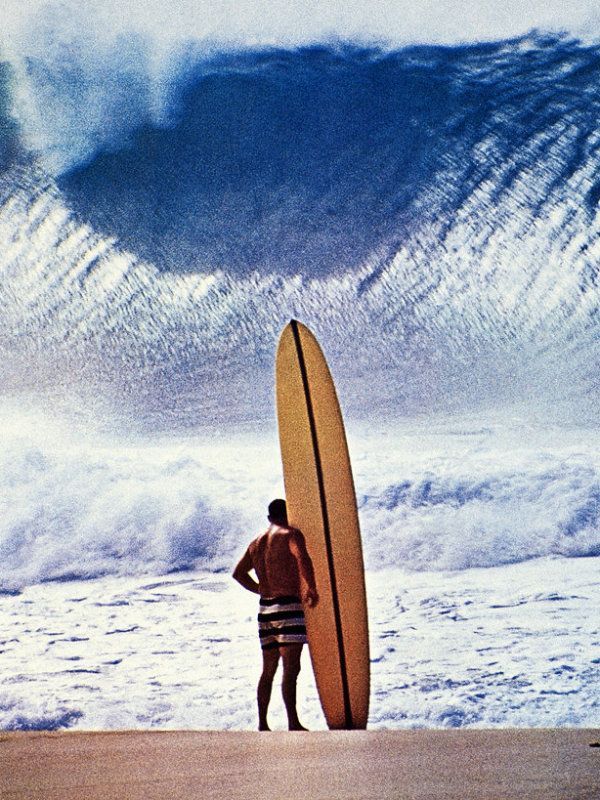History
Greg Noll’s Legendary Makaha Wave: The Biggest Ride of 1969
December 4, 1969
If you’ve ever stood on the shores of Oahu’s West Side, watching the Pacific churn under a winter swell, you know the raw power of Makaha. But on December 4, 1969, that power reached a whole new level—a day when Greg Noll, the fearless big-wave pioneer known as “Da Bull,” paddled into a wave that would etch his name into surfing lore forever. This wasn’t just a ride; it was a defining moment in surfing history. Let’s dive into the story of Greg Noll and his monster wave at Makaha in 1969.
The Man Called “Da Bull”
Greg Noll wasn’t your average surfer. Born in 1937, he grew up chasing waves along California’s coast before making his mark in Hawaii. By the late 1950s, he’d already conquered Waimea Bay, proving that big-wave surfing wasn’t just a myth—it was a calling. With his signature black-and-white striped board shorts and a larger-than-life personality, Noll earned the nickname “Da Bull” for his relentless, no-fear approach to the ocean’s heaviest beasts. But nothing could prepare him—or the surfing world—for what went down at Makaha in ‘69.
The Swell of the Century Hits Hawaii
December 1969 brought a storm that surfers still talk about in hushed tones. A massive low-pressure system in the North Pacific unleashed a swell so powerful it closed out most of Oahu’s breaks. Waimea Bay was unrideable, a chaotic mess of whitewater. The North Shore was a no-go. But over on the West Side, Makaha—a point break known for holding size—started lighting up like a beacon. Word spread fast: this was the swell of the century, and it was calling the boldest of the bold.
Noll, then 32 and at the peak of his big-wave career, heard the call. He grabbed his 11-foot gun—a board shaped specifically for giants—and headed to Makaha with a handful of other diehards. What they found was unlike anything they’d seen before: waves pushing 35 to 40 feet on the face, maybe more, rolling in with terrifying precision. The lineup was a ghost town; most surfers stayed on shore, jaws dropped, watching the ocean flex its muscles.
The Ride That Changed Everything
As the story goes, Noll didn’t hesitate. With the swell peaking on December 4, he paddled out into the chaos, his longboard slicing through the chop. The wave he chose wasn’t just big—it was a freak, a wall of water that seemed to swallow the horizon. Witnesses say it dwarfed anything ridden before, a moving mountain that tested the limits of what a human could paddle into without a tow rope or a jet ski.
Noll dropped in, heart pounding, as the wave roared behind him. For a fleeting moment, he stood tall, carving a line down the face of this liquid titan. But Makaha had other plans. The wave closed out, engulfing him in a violent wipeout that sent him tumbling through the impact zone. His board snapped like a twig, and he washed up on shore, battered but alive. That ride—estimated by some at over 40 feet—would be his last big-wave conquest.
“I paddled out, took off, and got annihilated,” Noll later recalled in interviews. “When I came up, I looked at the ocean and said, ‘That’s it. I’m done.’” And he meant it. After Makaha ‘69, Noll hung up his big-wave guns for good, leaving the sport at the height of his legend.
Myth, Mystery, and Missing Footage
Here’s where the story gets murky. How big was that wave, really? Estimates range from 35 to 50 feet, but without clear footage, it’s a debate that’s raged for decades. Australian filmmaker Alby Falzon claims he captured the ride on film, part of his work for The Morning of the Earth. Yet, the footage remains elusive, lost to time or locked away in some vault. Others who were there—like fellow surfer Buffalo Keaulana—swear it was the biggest wave ever paddled into at that point in history.
Skeptics argue the size got exaggerated in the retelling, a fish story grown larger with every beer shared at the bar. But for those who saw it, the truth is in the feeling: that day at Makaha was pure, unfiltered awe. Whether it was 35 feet or 50, Noll’s ride pushed the boundaries of what surfing could be.
The Legacy of “Da Bull”
Greg Noll’s Makaha moment wasn’t just a personal triumph—it was a turning point for big-wave surfing. In the years that followed, the sport evolved with better boards, safety gear, and eventually tow-in techniques. But in ‘69, it was still raw—man, board, and ocean, no safety nets. Noll’s decision to walk away after that ride only added to his mystique. He moved to California, became a fisherman, and later a board shaper, but his shadow never left the lineup.
Today, Makaha still hums with energy every winter, a reminder of the day “Da Bull” tamed its wildest beast. Greg Noll passed away in 2021, but his legacy lives on in every surfer who paddles out chasing the impossible.
Relive the Legend
The swell of December 1969 is long gone, but its echoes ripple through surfing history. At hawaii.surf, we’re all about celebrating these moments—the rides, the wipeouts, and the stories that make Hawaii the heart of surf culture. Got a favorite Greg Noll tale? Share it below, and let’s keep the stoke alive. Mahalo for reading, and see you in the lineup!

